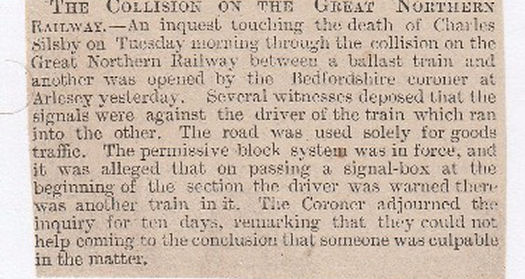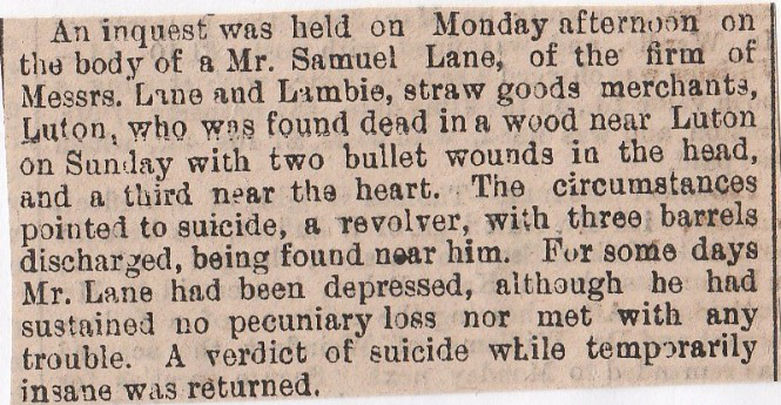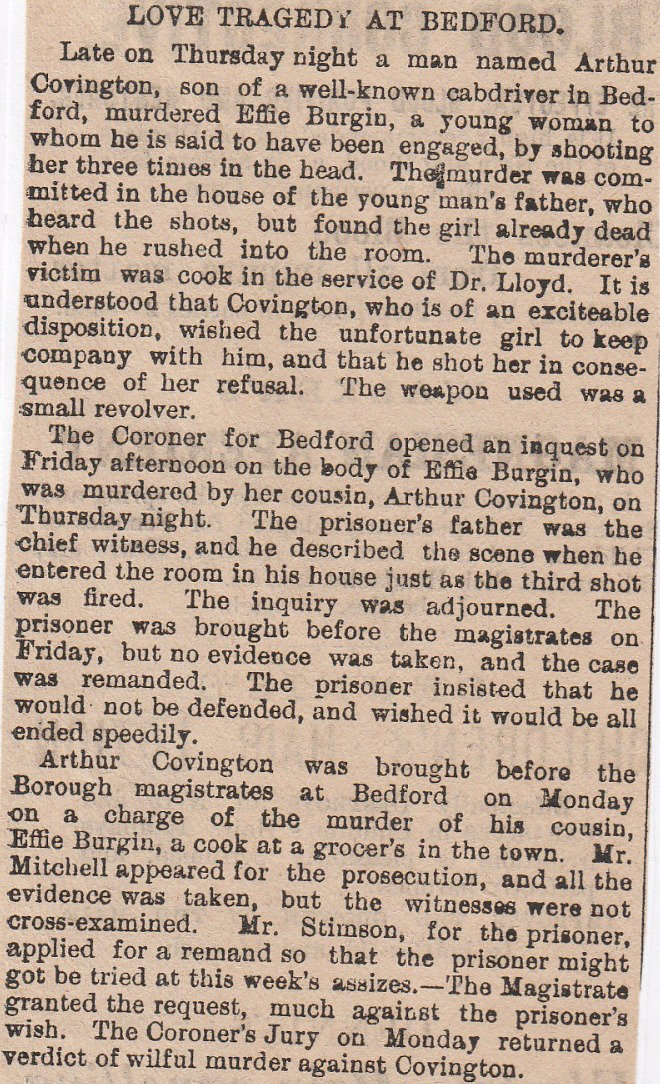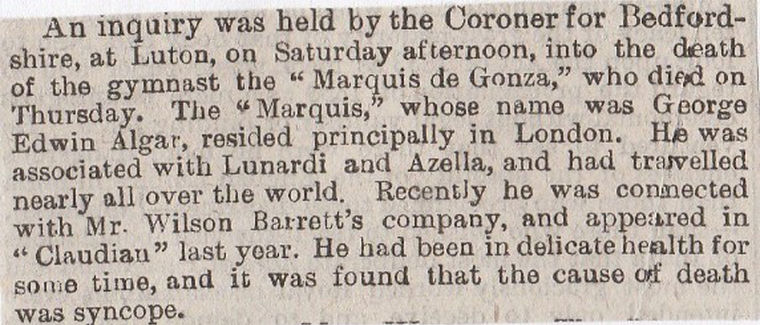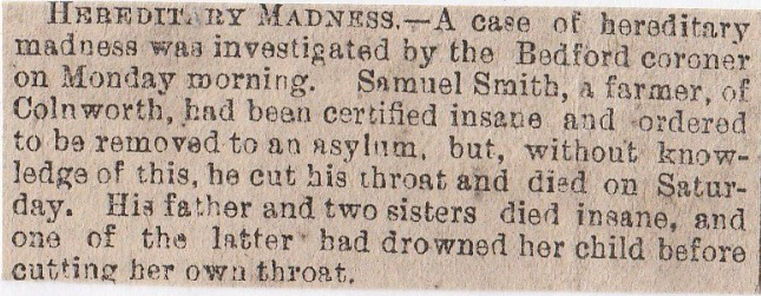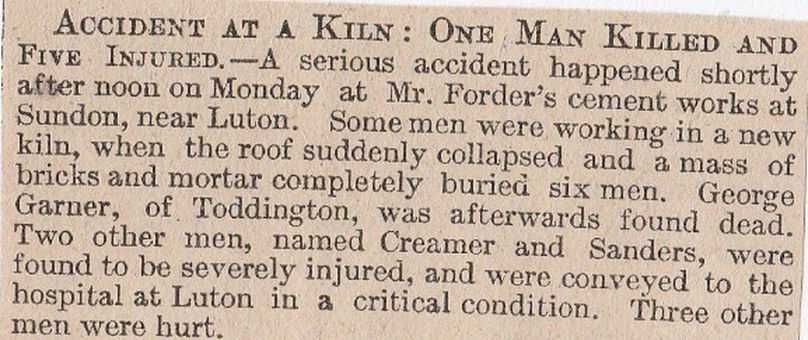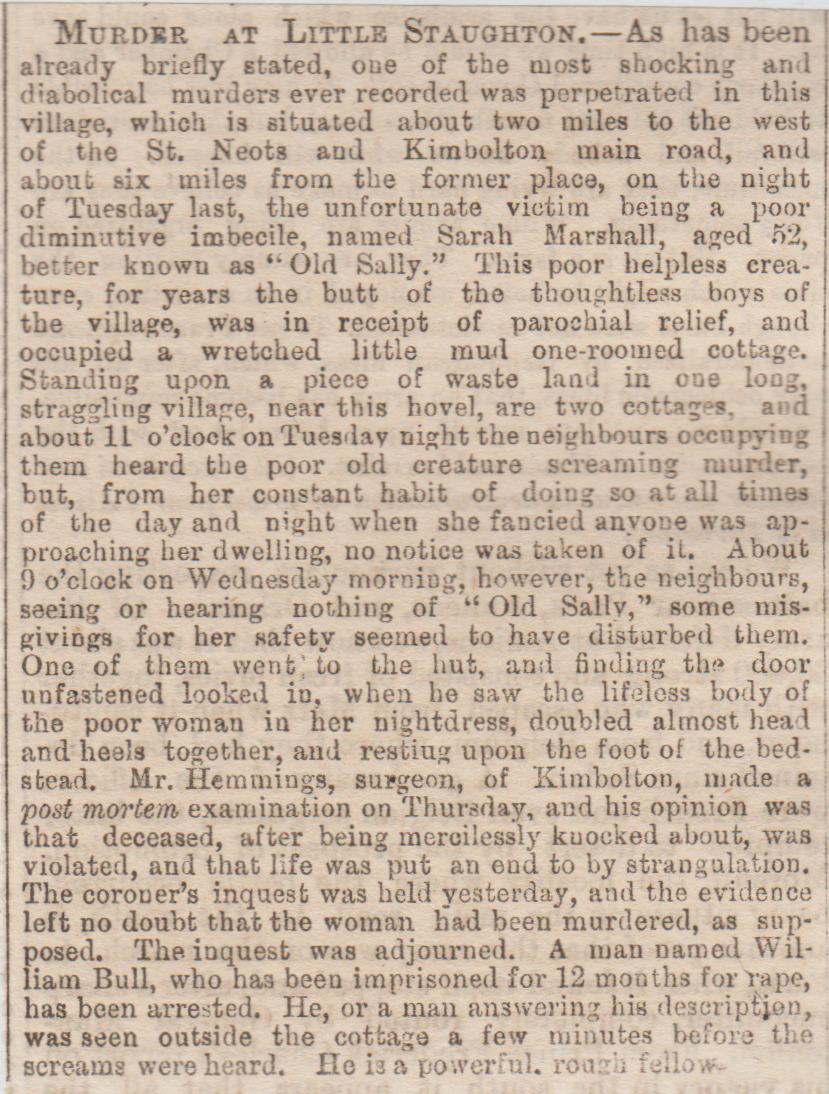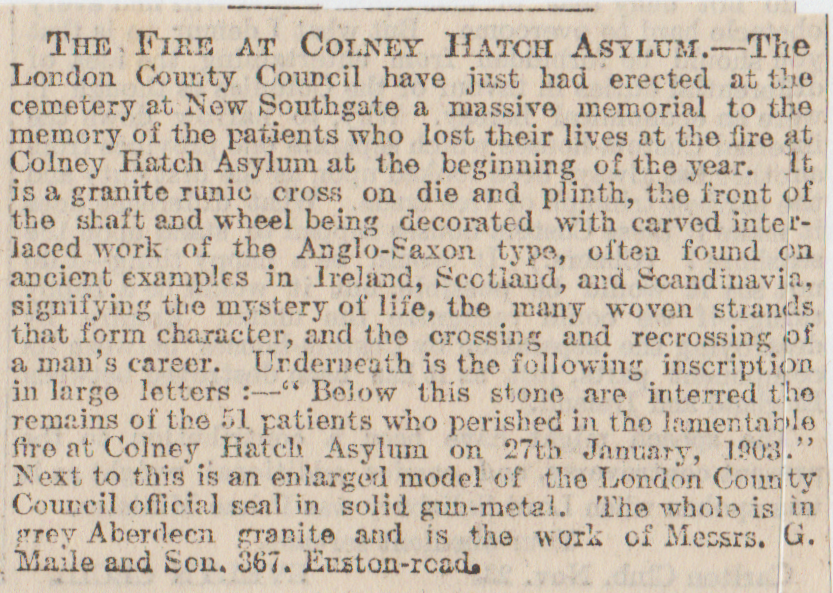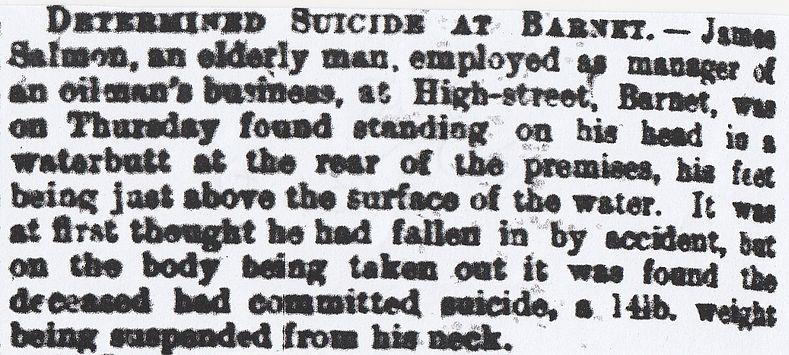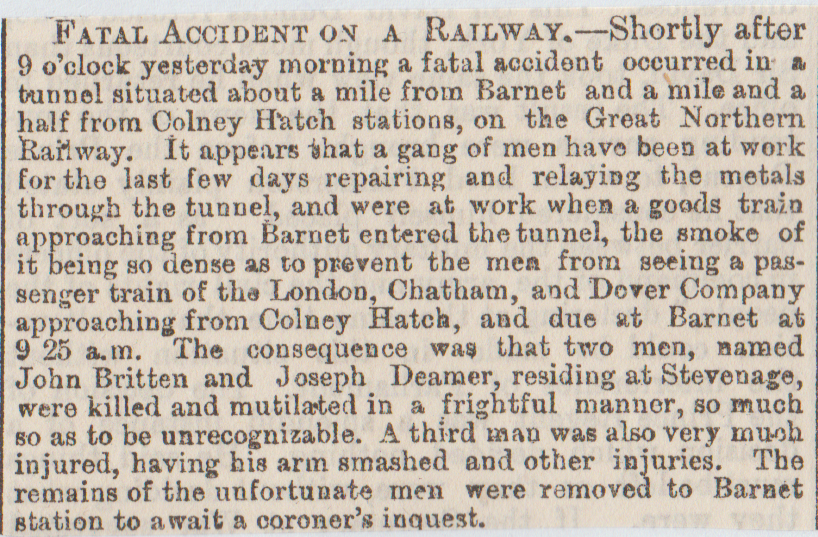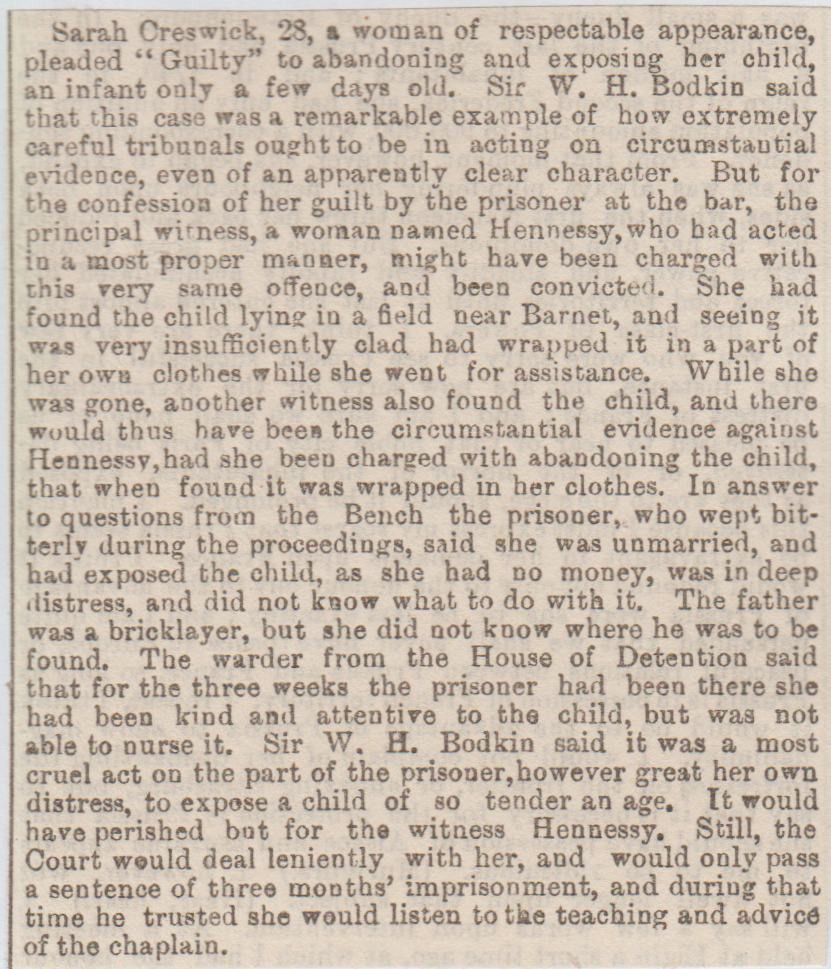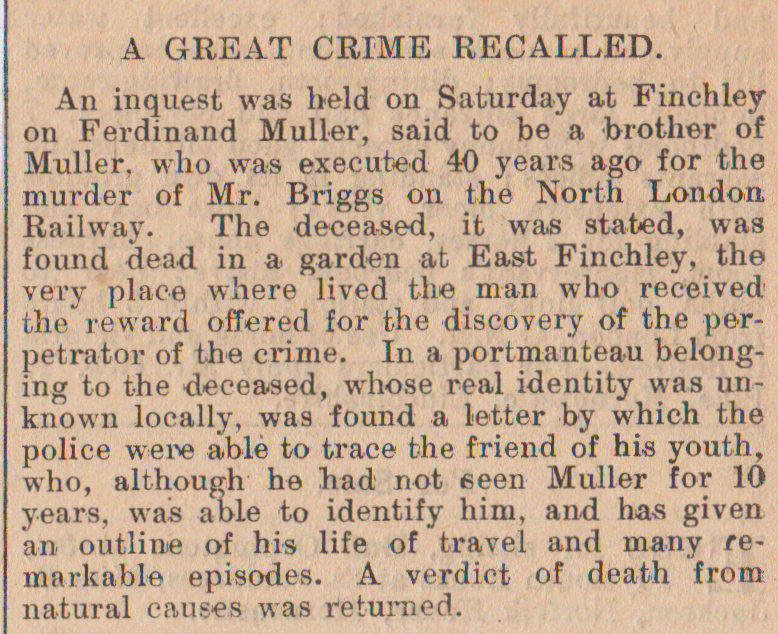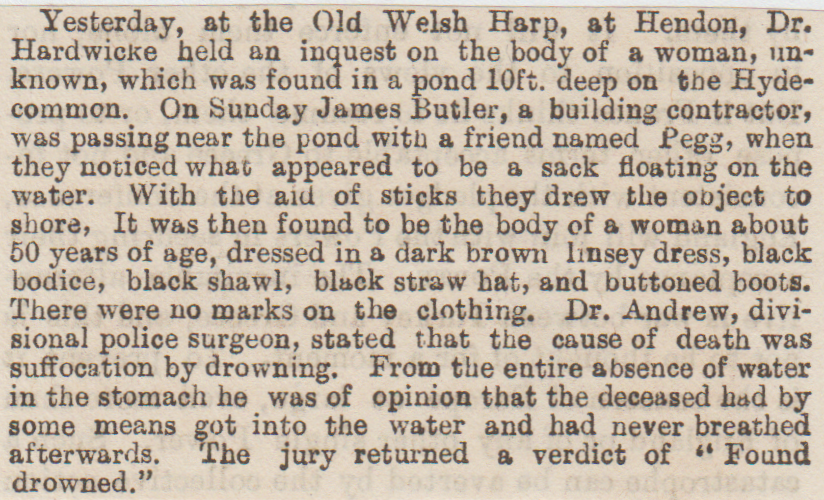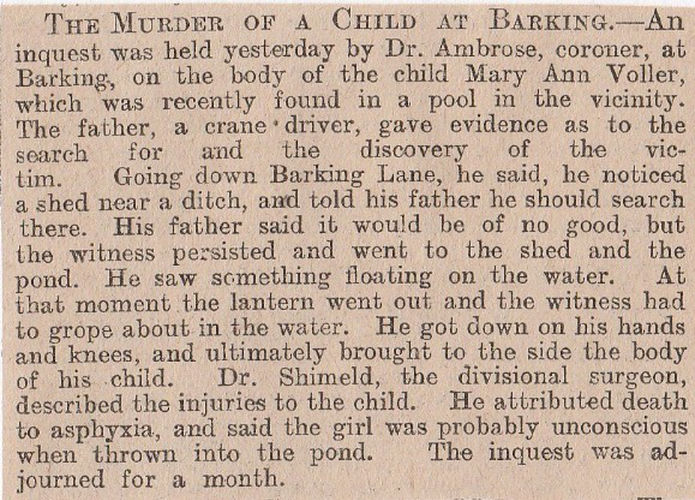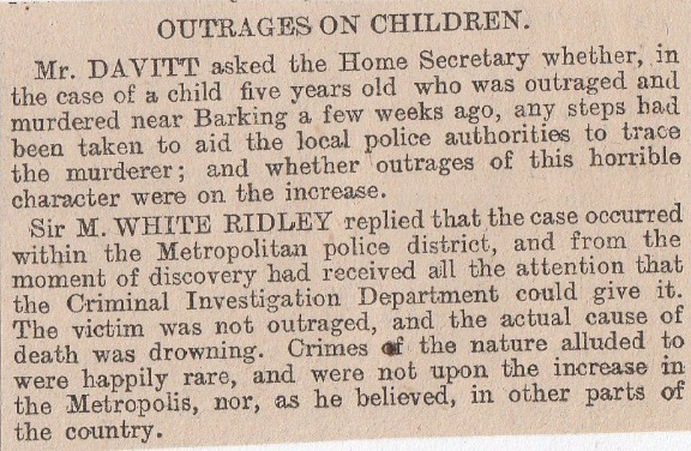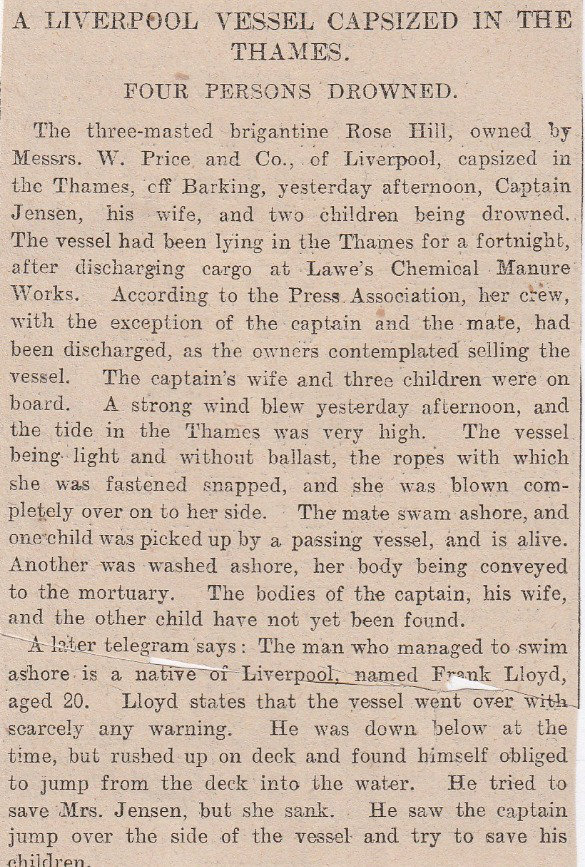1/ Windsor Castle Suicide, December 1863
A sentinel named Bradshaw was on duty at the gates of the Royal Mews when after about twenty minutes or so, he was found with a gunshot wound in the back of his head. His Enfield rifle was lying by his side and the ball was embedded in a wall. He had taken off his right shoe so that he could pull the trigger with his toe. His ammunition pouch had one round missing. He was in a precarious state at the Infantry Hospital in Clewer. (Did he die?)
2/ Windsor Castle Suicide, June 1878
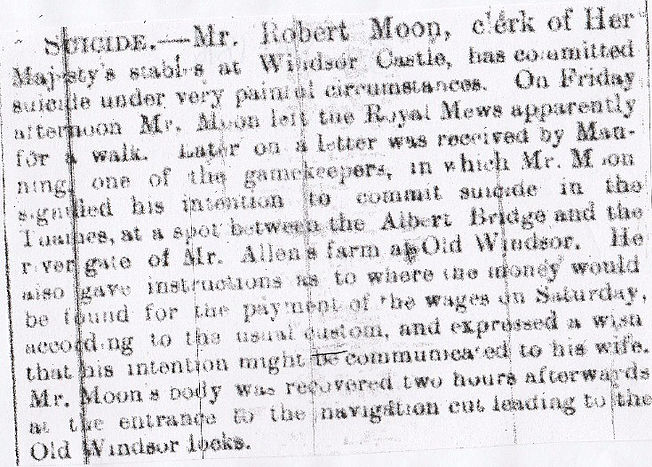
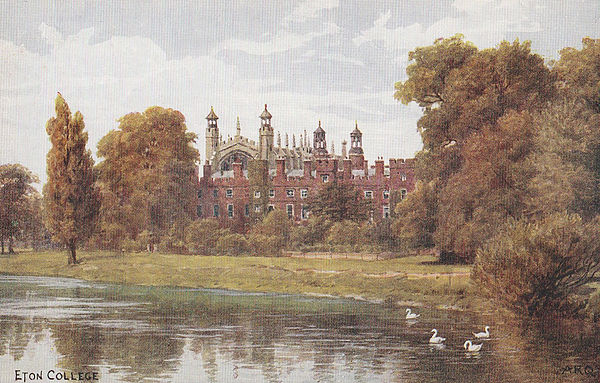 3/ Eton College Murder, January 1913.
3/ Eton College Murder, January 1913.
Annie Davis, a servant, who was employed by one of the Eton College master’s, residing at Cotton Hall, was murdered by Eric James Sedgwick.
Eric and Annie were sweethearts, and he had come from London to see her. Screaming was heard to come from the servant hall, a fellow servant bust open the door, and found Annie with a knife wound to the heart area.
Eric was arrested and gave them the murder weapon. The reason for the stabbing of his girlfriend was petty jealousy.
Eric was the last person hanged at Reading Gaol, shortly after the crime.
4/ Eton College Suicide, October 1891
Dr Philip Herbert Carpenter was a science master at Eton, but one thing preyed on his mind, and that was the history of mental problems in his family. So much so, that he decided to poison himself in his room.
Other problems included insomnia and some financial investments which could have gone slightly wrong, but his sanity was the main worry. He left a note saying just that, plus the fact he had ruined himself and left his wife and kids beggars, all through madness. “Suicide whilst temporarily insane” was the verdict.
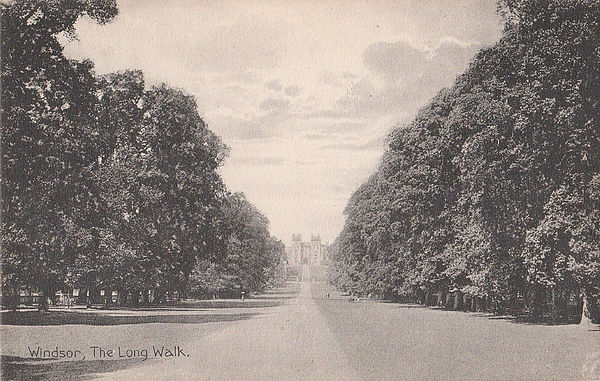 5/ Windsor Great Park, July 1879
5/ Windsor Great Park, July 1879
Ernest Alfred Nust was a nineteen-year-old on his way to a bean-feast dinner at the Catherine Wheel Inn. He was going to cycle from Kentish Town, where he lived to Egham where the inn was but he vanished into thin air. His father got a letter from him saying his bicycle broke down and he’d go by train. He made the feast then went to Windsor.
At Rhododendron Walk at the Bishop-gate side of the Park, they found Nust in among the bushes. The post-mortem found traces of corrosive poison in the blood-stream, so it is obvious that he took the poison and lay in the bushes to die.
6/ Hurley Manslaughter, November 1904
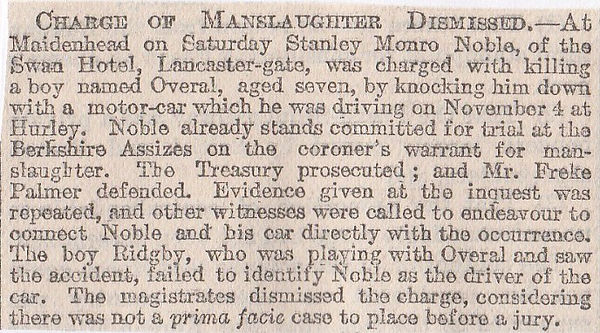
7/ Datchet Station Death, March 1898 (Decapitation)

 8/ Windsor Castle Suicide, July 1863
8/ Windsor Castle Suicide, July 1863
Martha Billings, a housemaid in the Castle, threw herself from the top of Queen Elizabeth’s Tower(similar to the picture) and died almost straight away.
Billings was good at her job and was an honest girl, but recently had been down in the dumps, and had told other members of staff that she wanted to die. Her family had a history of insanity, so it could have been in her genes.
Jury’s verdict was “Suicide while in a state of insanity.”
9/ Burghfield, Berkshire, August 1890 (Romantic Double Suicide)
19-year-old Rose Lunnon and her boyfriend Thomas Dawson, also 19 years old, were found in the River Kennet near Burghfield in Berkshire. Their wrists were tied together. They had been a couple for quite a while and were last seen three or four days before their bodies were discovered.
10/ White Hart Hotel, Windsor, January 1885

11/ Ascot Murder/Suicide, August 1901
A six-year-old boy walked into the Berkshire Constabulary on Oriental Road, Sunning Hill, near Ascot, and told Sergeant Gibbs that his mother and father were arguing and shouting at each other. The policeman didn’t expect to find two dead bodies when he followed up the little boy’s plea for help. He went into the house of Edwin Lunn and found him and Mrs Lunn lying on the floor covered in blood. Mrs Lunn had her head smashed in and her throat had been cut, and Lunn just had cut his throat. The six children were woken up one morning by screaming and the six-year-old boy saw his Dad standing over his mother hitting her with a poker. It was these actions that prompted him to go to the police station. Police found the poker covered in blood. Neighbours, when questioned, said they saw them the previous night and both seemed very lovey-dovey!
12/ Reading, Berkshire, August 1873 (Five Skeletons)
A group of navvies were digging for the Reading Drainage Works when a few feet from the surface they stumbled upon five skeletons in a perfect state of preservation. A medical gentleman saw them and said that one was of a woman. It is thought they were “contemporaneous with the Commonwealth”. As was common in Victorian times, instead of finding out who they were or how they died, they buried them where they were discovered. (Still there?)
13/ Hungerford, September 1885

14/ Sunningdale, October 1890 (Human Remains)
While some drains were being dug on Broomhall Farm, Sunningdale, under the occupation of Mr William Farmer, one of the City of London sheriffs, some bones were found and several human skulls.Among the debris was portions of coffin planks, around five inches thick.They are supposed to have stumbled upon an old burial ground of a monastery which once stood there, about four hundred years ago.Remains were re-interred.
15/ Windsor, October 1875
A 13-year-old lad named Beasley, an innkeeper’s son from Windsor killed himself. The reason was that he was told to clean his father’s boots, so he went up to the loft. The dog of the innkeeper went down the stairs of the loft and then up again, to draw attention to itself. The father went up and saw his son hanging by some cord, which he’d tied to the door handle and then thrown it over the door, and hung himself that way.
16/ Victoria Barracks, Windsor, September 1900
Early on a Sunday morning at Victoria Barracks, Windsor, the corpse of Corporal Robert Lee, of the 1st Battalion Grenadier Guards, was found lying on the ground in a terribly mangled condition. Either he’d jumped from one of the upper barrack rooms, or he had fallen, in an awful accident. Lee was taken to the Windsor Royal Infirmary with a fractured skull, dislocated wrist and elbow, plus other injuries. The 23-year-old died shortly after being admitted and colleagues said that his behaviour of late was strange.
17/ Ascot, September 1919 (Lake Mystery)
Sunninghill Park, near Ascot racecourse, turned up the bodies of a young man and girl, who were named as William Edward Sarney,18, and his girlfriend Emily Mason, also 18, both drowned in a lake. Sarney lived at his parent’s house at Woodside, Winfield, and she was employed at a hotel in Ascot. The young lad who found them, Charles Cordery, is a garden boy, and on the lake bank there was the girl’s hat, and his cap (inside that was £6 in notes) Was it a suicide pact? Had the money been stolen and a guilty conscience led them to jump in the lake?
18/ Reading Station Death, April 1905
A terrible accident occurred at Reading Station when a lady was on the platform of the GWR and was waving to another person on the other platform, she failed to spot the approaching train. Someone shouted, “Stand back!” , but she stepped forward, the train clipped her and she went under, being sliced to pieces. What was left of her was gathered up and taken to the local mortuary. Family members identified her as Miss Nancy Butler, schoolmistress of Hampstead Norris. The people she was waving to, were her Mum and a friend, and if they had not been there to see the sickening spectacle, then her identification would not have been possible.
19/ Reading, November 1894 (Steam Roller Accident)
A young man named Simmonds was employed to walk beside a steamroller and was meant to tell the driver to stop when necessary.He became dizzy and fell under the rollers, which completely squashed him flat. His rib-cage was flattened and death was immediate, leaving the body an appalling mess.
20/ Braywick Road, Maidenhead, May 1903 (Honeymoon Suicide)
Gordon J.Spriggs married Miss Evelyne Hughes, an actress on tour with the “Belle of New York”. They stayed at Ye Shantie, Braywick, as part of their honeymoon on a road trip to Paris. Spriggs left his wife for London on a train, she’d follow up later, but he had got about half a mile out when he put a revolver to his head and fired! First on the scene was the Vicar of Bray (C.A.Raymond), he prayed with others while help was got. Spriggs was eventually taken to Maidenhead Cottage Hospital but died after an hour. (Why get married then?)
21/ Windsor Castle Lunatic, July 1885
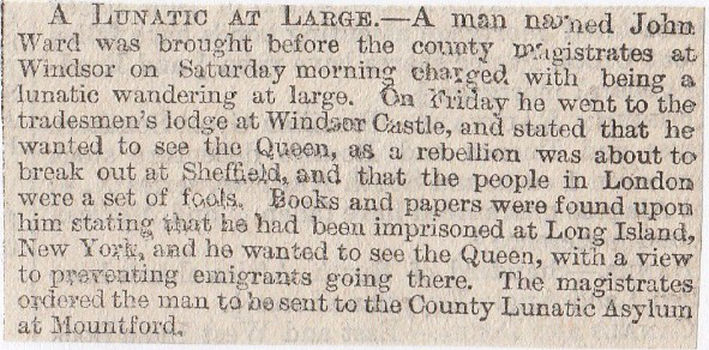
22/ Royal Military College Murder, Sandhurst, December 1890 (Murder/Suicide)
A dreadful murder was committed at the Royal Military College, Yorktown, near Sandhurst.Mrs Gregg, wife of Major Gregg, of the Leicester Regiment, shot her mother who was sleeping with her and then cut her throat with a razor. It seems that 27-year-old Mrs Gregg got a severe chill a few days before and then dementia followed. The Major wanted to send her to an asylum but his mother-in-law, Mrs Atkins, who’d just arrived from Ireland, would not allow it. The husband called a doctor, and he pronounced them both dead, then the rooms were locked and sealed.
23/ Slough Murder, August 1900
The nine-year-old daughter of a bricklayer, named Smith, living at Colnbrook, was sent to the shops in the village. When she didn’t return, locals and police went looking for her. It was not until three days later her limp body was found in a shed at Poyle Mills. The clip says she was “fearfully treated”, (presumably been molested).
24/ Reading Gaol Suicide, April 1888
More famous for its ballad by Oscar Wilde, this was the scene of a suicide of an inmate. Henry Strong was charged with attempted murder on his wife, by beating her with a pair of tongs, and his punishment was incarceration in Reading Gaol. Rather than the usual hanging in his cell, he plummeted from a landing onto the stone floor below and died from his injuries.
25/ Windsor Suicide, September 1881
The village of Old Windsor, was the scene of great excitement, as news came through that a young man of the area had killed himself. John Dixon, the groom of Sir Reginald Cathcart, of Titness Park, had been going out with an 18-year-old daughter of Mr and Mrs Pullin. Recently she’d dumped him for another and his anger was uncontrollable. Dixon went to the Pullins house and hid in the garden till they returned. Mrs Pullin and her daughter had been to church, and when Dixon saw them coming up the road he slit his throat and ran towards them both. The daughter screamed “Mother, he’s cutting his throat!”, and Dixon with a razor in hand staggered towards them, they ran off to get help.When it all calmed down he was taken to Windsor Royal where he died despite all efforts by staff to save him, when he ripped open the wound in his neck.
26/ Maidenhead Mystery, July 1902 (Concealment of Birth)
Ellen Sarah Horwood, of White Waltham, stabbed her child fifty times in a bid to rid herself of the infant. Its lower jaw was smashed, back of the skull shattered, and the 50 little holes, some an inch deep, were probably from a hat-pin. they pierced her heart and lungs and the abdomen. It suffered so badly, but the jury came up with the verdict of “Accidental Death”. (What happened after?)
27/ Slough Suicide, March 1919
A young girl, Rose Florence Morten aged eighteen, was told by her father after rolling in late from visiting a picture theatre with a U.S. soldier that “her place was in bed”, she walked out and slammed the door behind her. She met the soldier but he told her to go home, and this depressed her. She went to the canal and plunged in. The coroner praised the soldier for his sensible advice, and it was ascertained she committed suicide in a fit of anger and while temporarily insane.
28/ Windsor Murder, January 6th, 1885
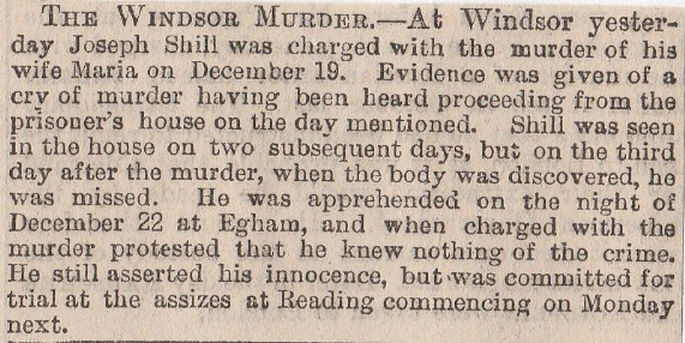
29/ Windsor Murder, January 14th, 1885
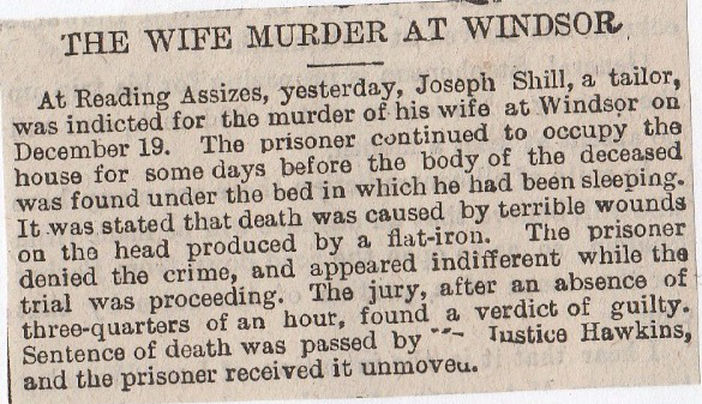
Windsor, January 14th, 1885
At Reading Assizes Joseph Shill, a tailor, was convicted of the murder of his wife at Windsor, on the 19th of December, was sentenced to death.
Windsor, January 30th, 1885
The High Sheriff of Berkshire Received an intimation yesterday of the respite of Joseph Shill, who is believed to be insane. His execution had been fixed for Monday next.
30/ Reading, July 1872 (Two Suicide Drownings)
The first was Rose Moore, a good-looking 20-year-old, had been seeing a bloke called Knapp, who was a brewer by trade. The two had a spat, and she sent him a letter (Victorian text) asking him to meet her that night at 8:30 p.m. He turned up at eight p.m., hung around for a bit then left. Rose looked for him at the meeting place but he didn’t turn up, so she went into The Forbury with her friend, wrote him a letter, then drowned herself in the Thames. The letter said: “To live without I could not. God forgive you, for you are the cause of my death, but I forgive you- Goodbye, and may God bless you, my darling boy, is the last prayer of your heart-broken Rosa”. The verdict was “Temporary Insanity”.
The other drowning was at Caversham(River Thames) and a young lass named Rhoda Piercey. She drowned herself because she thought her boyfriend was going to dump her for some other girl. Again the verdict was “Temporary Insanity”.
31/ Boveney Court, Windsor, December 1898 (Human Remains)
Near to the place where the Windsor servant girl was killed in the summer of 1898, some human remains were found. Three men digging at Boveney Court, owned by Mrs Fitz-Simmonds, were near a fruit tree when they found some arm and a pair of femurs and a spinal column. The Constabulary sent a couple of officers and they took them to a medical examiner who did tests on them and said they were of a female, and had been at least ten years buried in the ground. The murder last summer was on the Berkshire side of the river. (Who was she?/Murderer?)
32/ Maidenhead, October 1904 (Hanging for Five Weeks)
Two policemen entered a house by breaking the bedroom window in order to find out if the owner, a man called Webb, was inside and all right. He’d not been heard of for a number of weeks so his sister asked the police to search for him as she was worried something had happened to him. It was not unusual for him to float off for days at a time, but not weeks. The police saw his body hanging from the door. Webb had tied a rope to the handle, thrown it over the top of the door and made a noose and strangled himself. Coroner suggested he’d been there for five weeks or so. No reason is known as to why he did this.
33/ Oakley Green near Windsor, November 1886
53-year-old Joseph Harper was sacked from his job at The Hatch, the Marquis of Aylesbury’s home, where he’d been in employment for nine years, for no apparent reason. He had been depressed for a while and he was found with a razor in his hand with a huge gash in his throat. The verdict was “Suicide while Temporary Insane”.
34/ Old Windsor, June 1858
John Marlow used to go for a daily jaunt along the banks of the Thames, being drawn by two boys in an easy chair. He sent one of them to get some gingerbread from the Bells of Ouzeley, a fishing house, then he gave his hat and stick to the other lad, and said “Goodbye William”. He then rolled down the bank and into the river. The boy shouted for help but his body took a full day to recover. It was found near Magna Charta Island.
35/ Sonning Bridge near Reading, December 1910 (Suicide at Same Place as Friend’s Suicide)
Lilian Margaret Chambers, 26-year-old from Reading, was found on the GWR line at Sonning Bridge near Reading. Lilian was unemployed and lived at home and she had been seeing a man about four or five years ago, to whom she became very much attached to. However, he committed suicide at the same place as she had decided to, a couple of years before, and this had preyed on her mind. It is believed she stood on the bridge and when the train approached, she fell forward on to the rails where the carriages passed over her body. (Wanted to be with him?)
36/ Cranbourne Terrace, Windsor, July 1907
A house in Cranbourne Terrace, Oxford Road, Windsor, was the scene of the murder of a 14-year-old girl by the name of Unity Annie Butler, who was found under her bed with strangulation marks on her neck. The parents had taken in a lodger, William Austen, also known as Saunders, who was a brewer’s labourer. The father had left home at four, leaving Unity on her own. When they all got back they couldn’t find her and thought she’d gone to her uncle’s. Time began to tick on and still no sign of her, so Mr and Mrs Butler went to see the uncle, but no joy there! It got to eleven p.m. and even the lodger hadn’t turned up so they put two and two together, and searched the house. Sadly they came across a bundle underneath a bed, and obviously, it was Unity. The murderer had stuffed a handkerchief in her mouth to prevent screaming. A piece of cord was around her neck, and hands tied up too, both had left strong ligature marks. An immediate search was instigated to look for Saunders, and two men came forward to say they saw him on his way to Maidenhead. (Was he caught?/Was he the murderer?)
37/ Slough Murder, April 1881

38/ Eton Drowning, July 1882
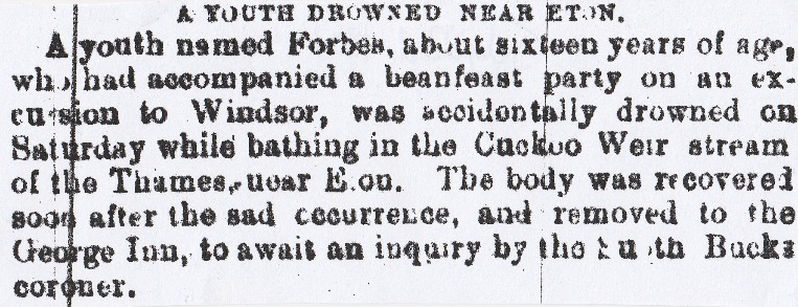
39/ Windsor Theatre Fatality, December 1844
Just as the performance was getting ready to start, a tragic accident took place at the Windsor Theatre, when a man named Hume with his wife and daughter were about to get sat down, when the woman, who is about sixty, tripped on her cloak and fell over the railings and into the pit below. The fall was one of about 30 feet, and to make matters worse she landed on her back, causing massive spinal injuries, and broke both legs. The lady was taken to her residence in Eton but sadly died on the way. (Where was Windsor Theatre?)
40/ Ufton Gun Accident, September 1870
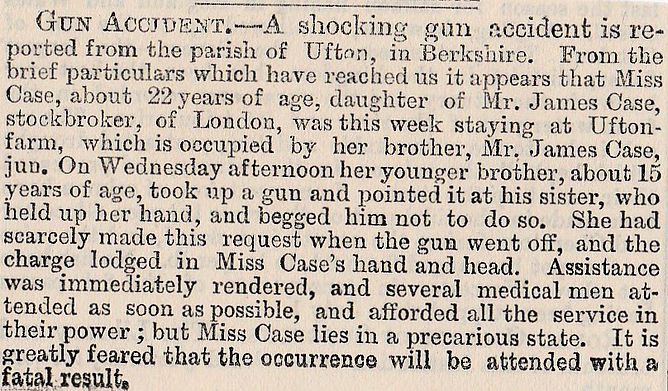
41/ Lunatic at Windsor Castle, August 1870
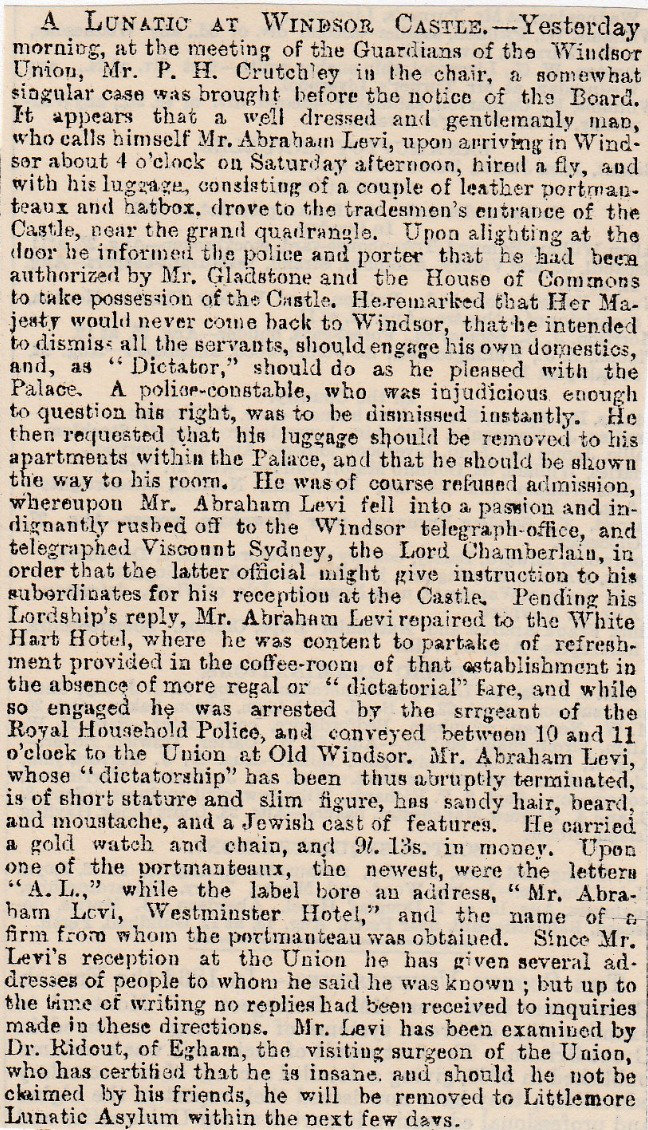
42/ Fatality in Windsor Park, July 18th, 1870

Frogmore House and Gardens are still there, with “Long Walk” nearby. Mausoleum, now the Duchess of Kent Mausoleum in Frogmore House Gardens.
43/ Fatality in Windsor Park, July 19th, 1870
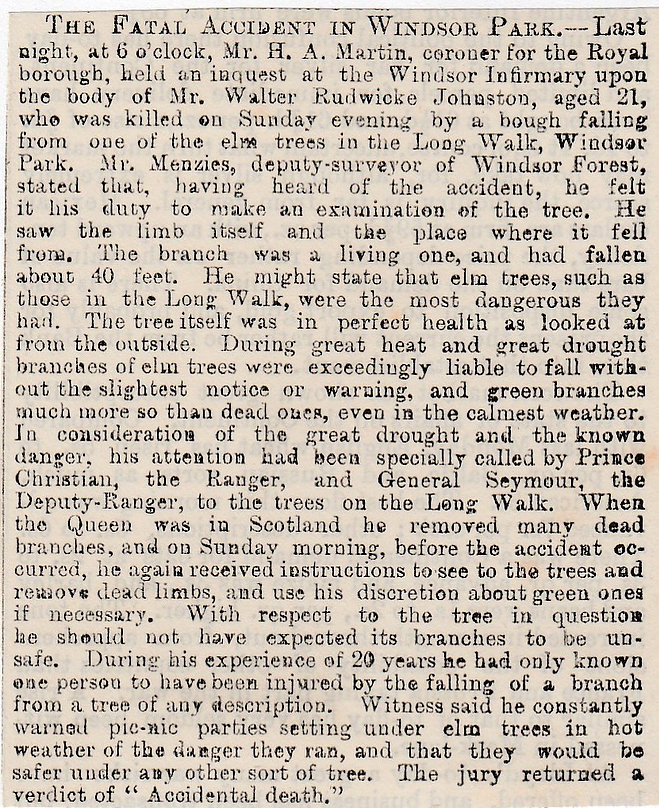
44/ Aldermaston Railway Fatality, December 1870
Yesterday afternoon a labouring man was killed by a train near Aldermaston station, on the Hungerford branch of the Great Western Railway. His body was mutilated in a dreadful manner and both legs were cut off. It is supposed that he was crossing the line at the time the train was approaching. The remains were removed to a neighbouring public house to await an inquest.
45/ Bearwood Lake Drowning, December 27th 1870 (Bearwood Lake estate is now part of Bearwood Lake Golf Club. I presume the said lake is there still)
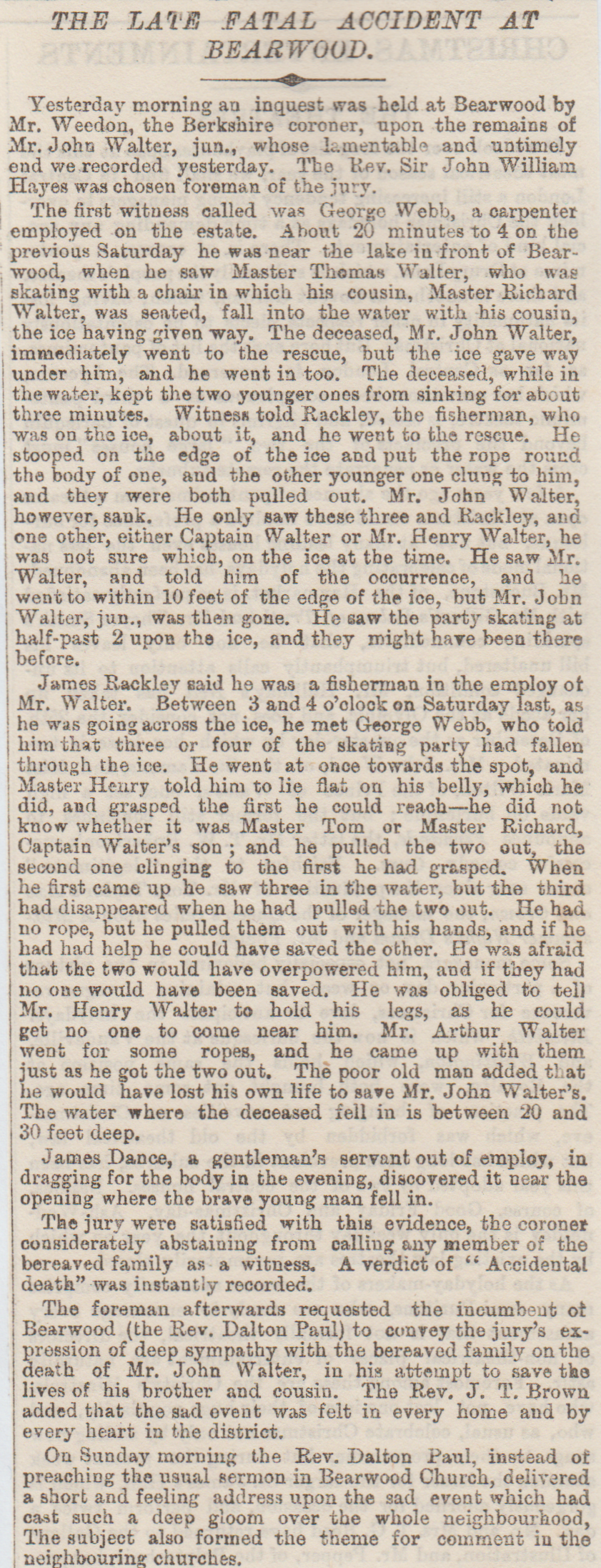
December 26th, 1870 (Sorry, this was the day befores headline!)


46/ Suicide at Rectory House, Datchet. January 1866 (It is near Windsor Castle)
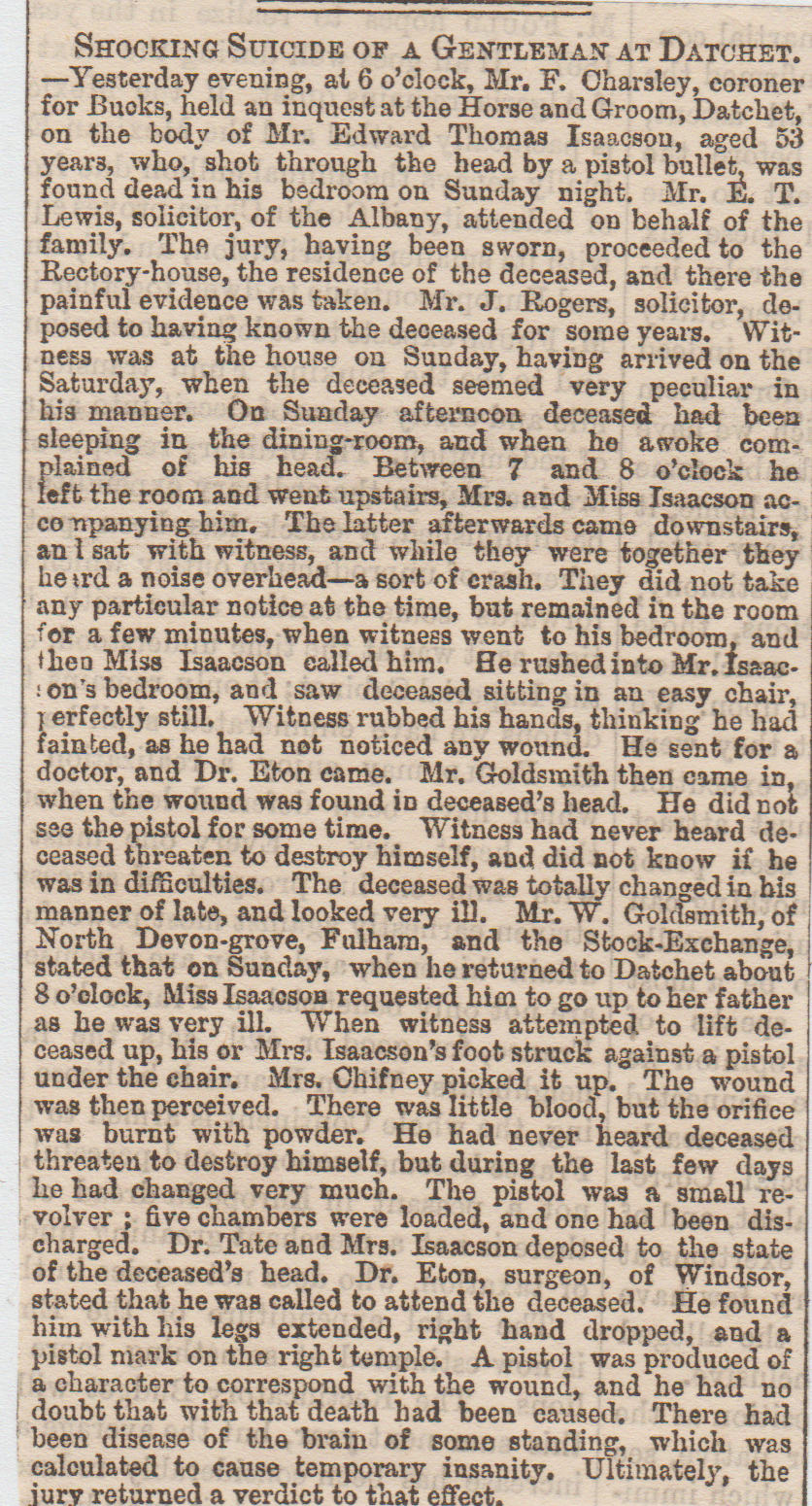
47/ Caversham Hill House Suicide, January 1866 (Caversham is a suburb of Reading)
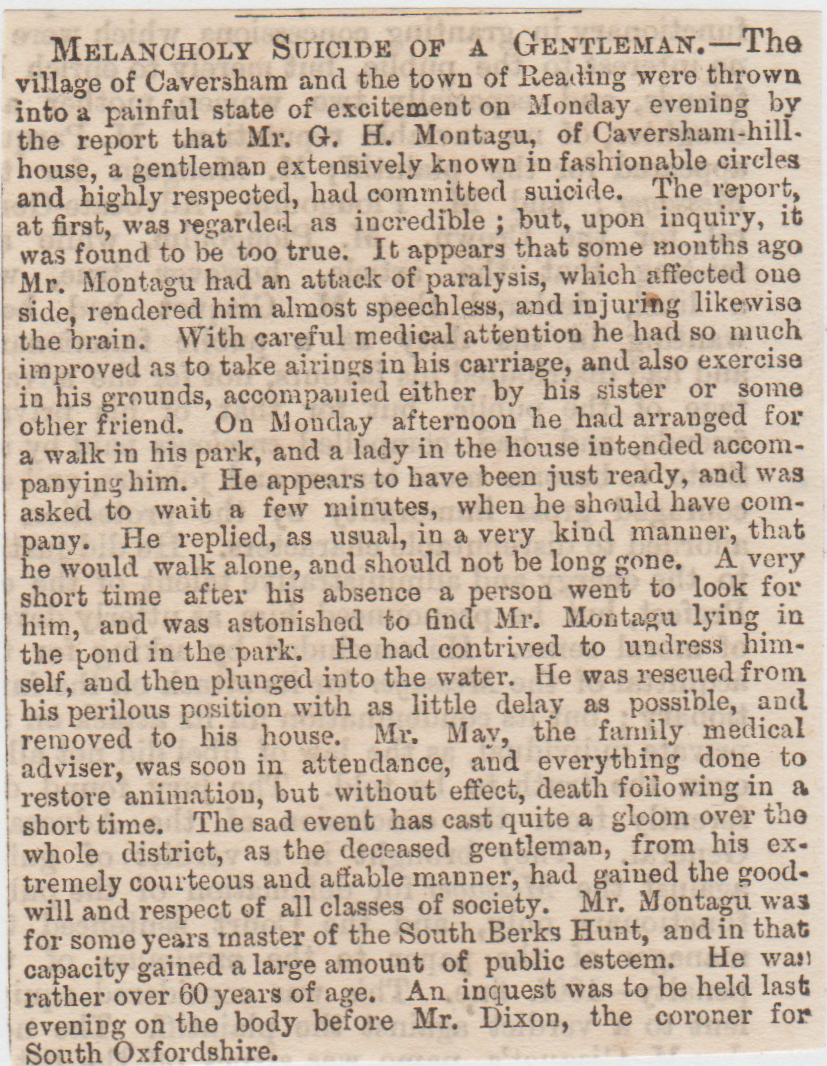
48/ Drowning near the Bells Of Ouseley, Windsor. February 1866 (Bells of Ouseley pub is still there, and now a Harvester)
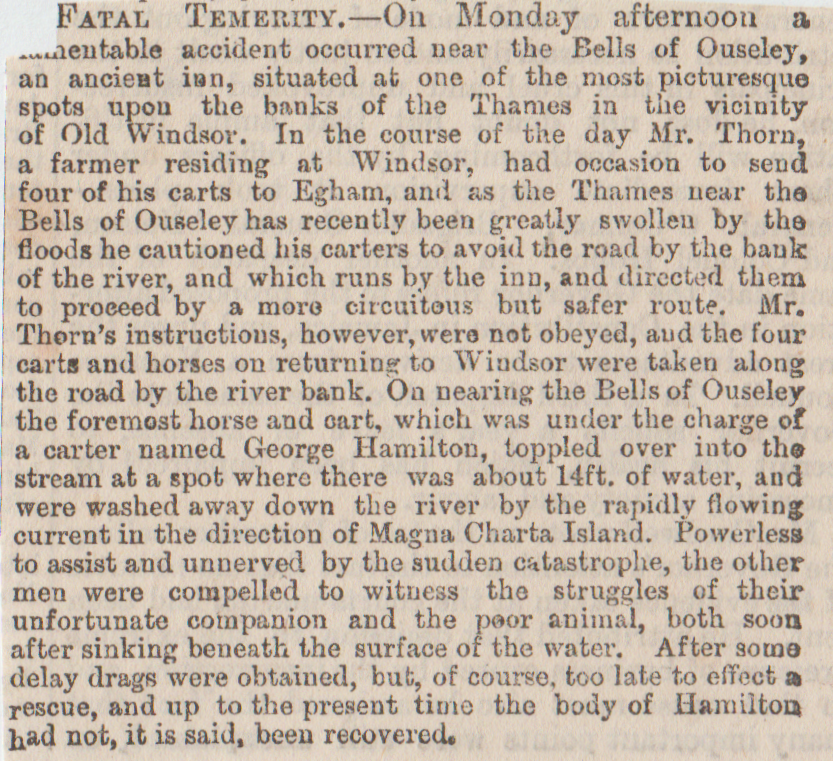
49/ Railway Fatality near Reading Station, May 1866. (Flying Horse pub has long gone I expect)
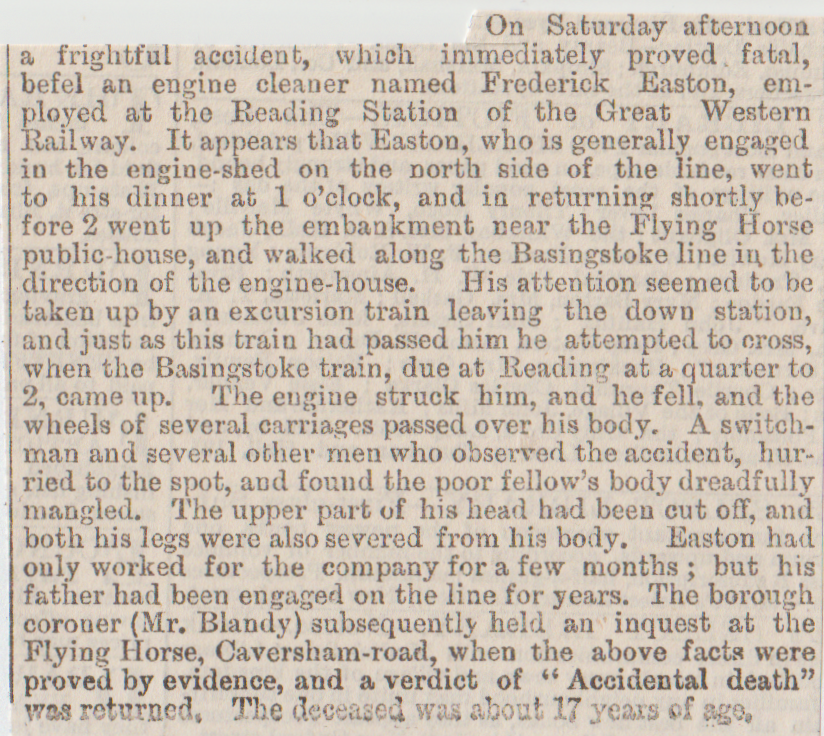
50/ Fatal Gun Accident near Bray, January 1866

51/ Gamekeeper Killed, Waltham St Lawrence. October 1866
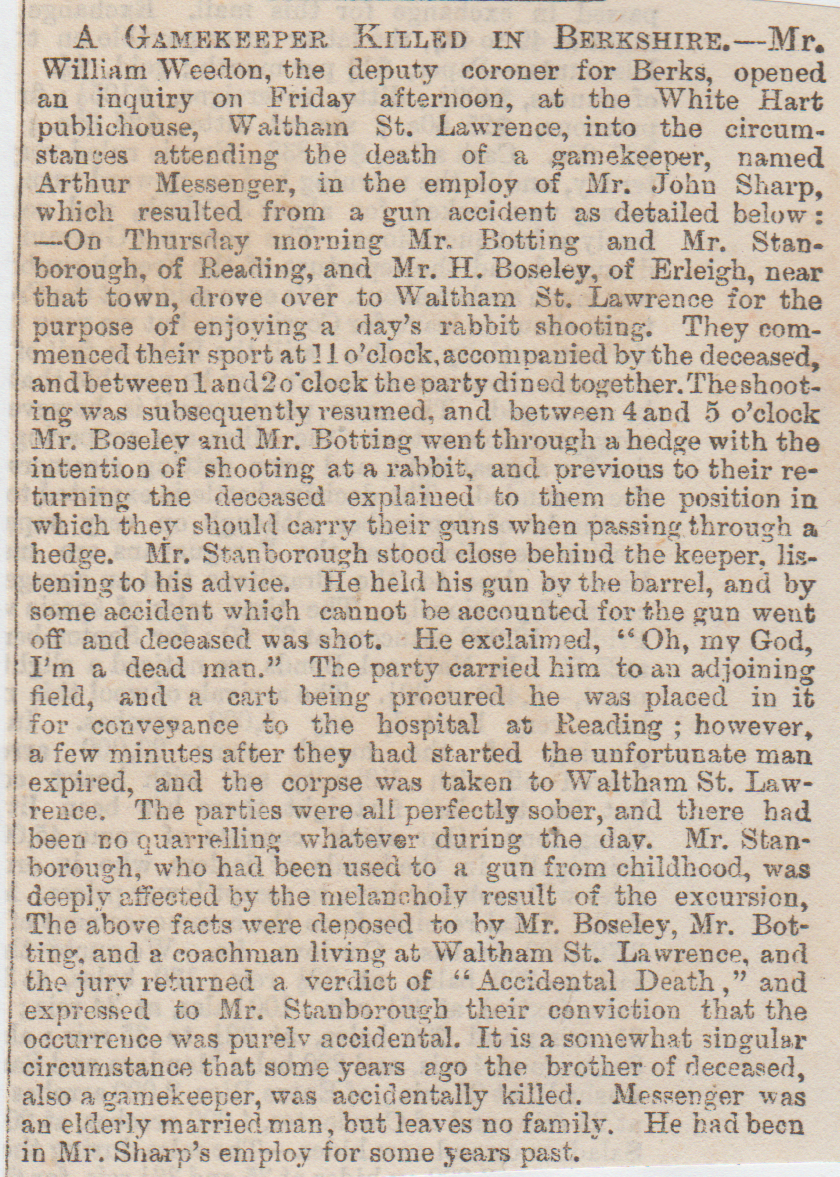
52/ Fatal Railway Accident at Reading, December 1866
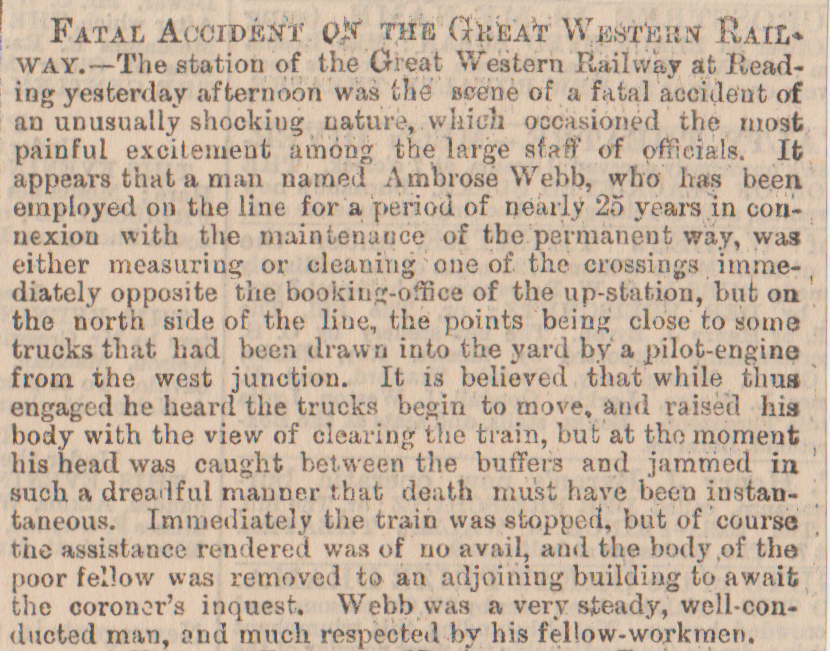
53/ Double Murder/Suicide at Newbury, December 1866 (Crown- Northbrook St/ Rose & Thistle- 90, Northbrook St)

54/ Reading Railman Froze to Death, January 1867.
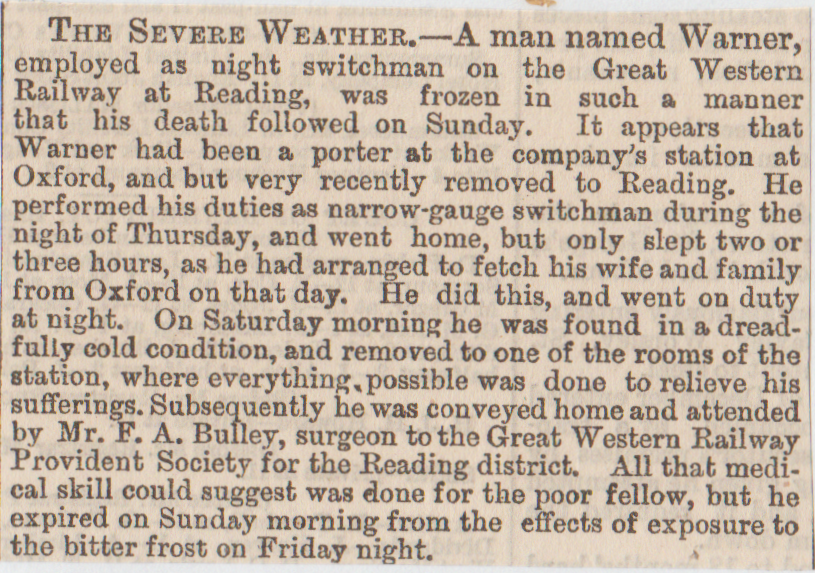
55/ Sonning Cutting Fatal Accident, January 1867
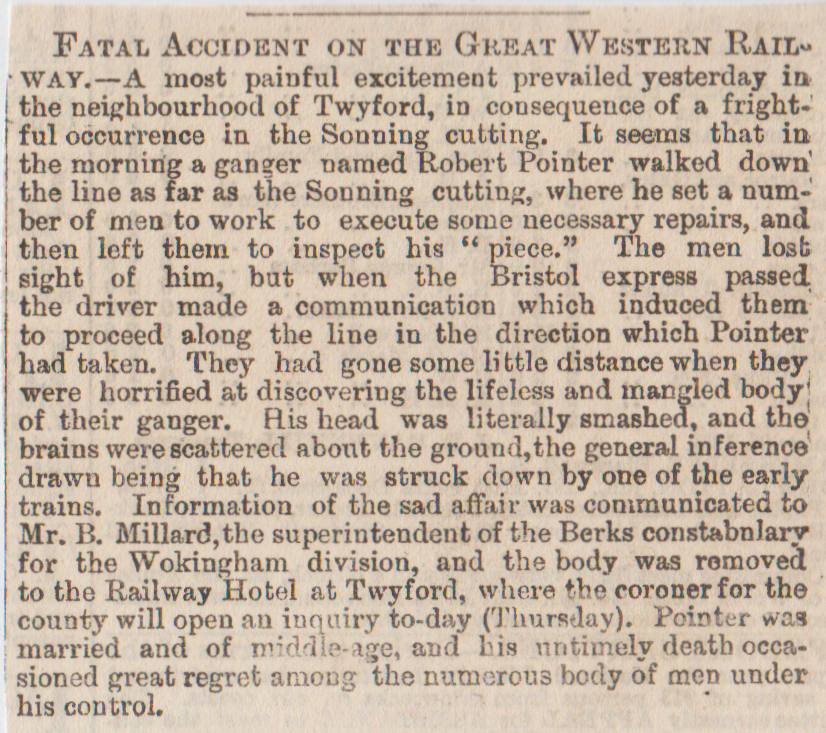
56/ Bandman Killed by Horse, Windsor. March 1867 (Household Cavalry Regiment, Combermere Barracks, St Leonards Rd- The Household Cavalry Museum is across the road)

57/ Fatal Carriage Accident, near Eton College. October 1906.
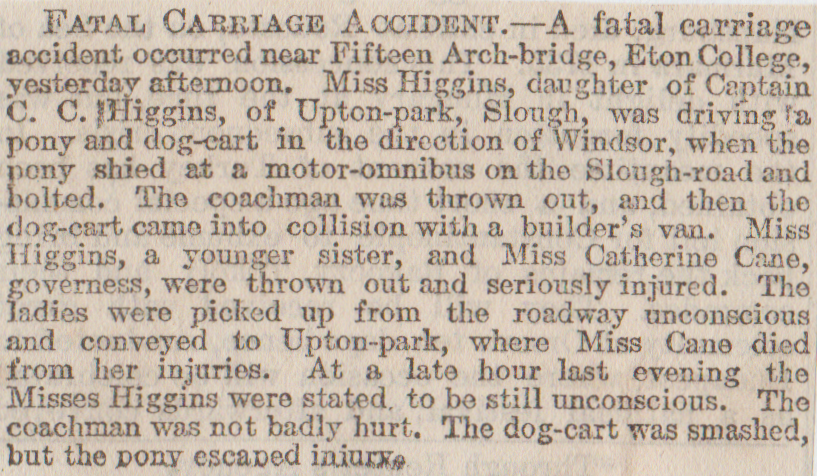
58/ Suicide in the Old Malt House, Hurley, near Marlow. June 1907
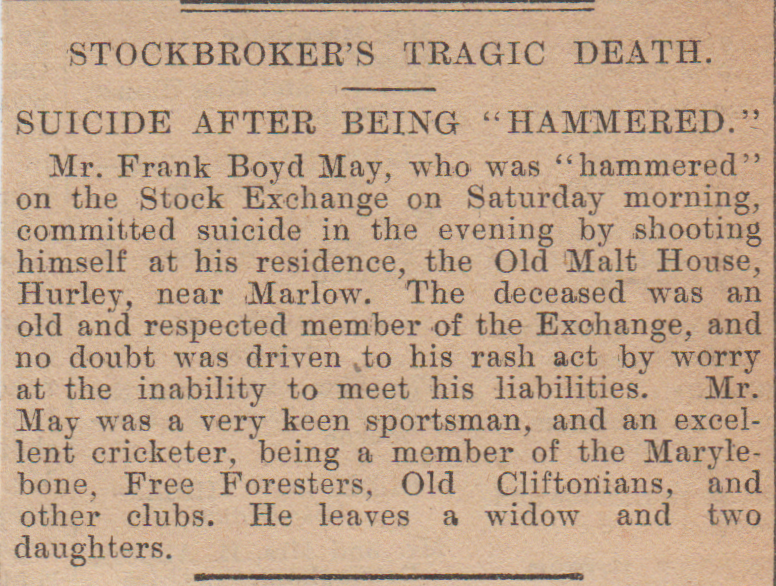
59/ Murder of Unity Butler, Clewer near Windsor. October 1907. (What a beautiful name- Unity Butler)
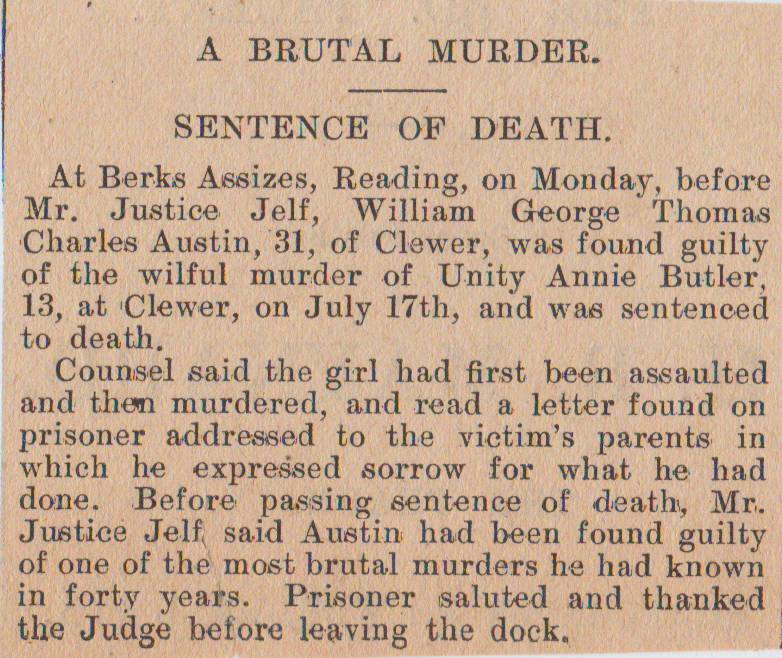
60/ Slough Murder/Suicide. November 1907 (Charles Squires kills Hilda Cooke)
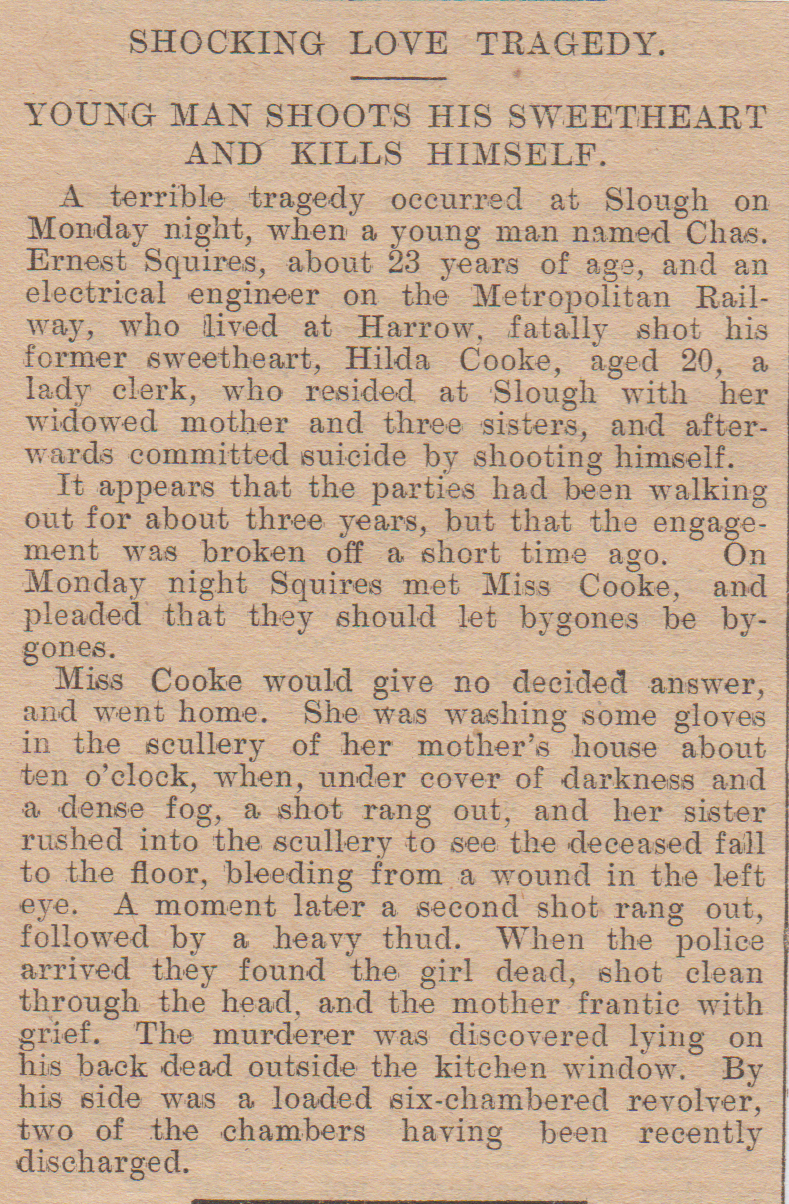
61/ A Woman Killed at Twyford Station, near Reading. December 1880
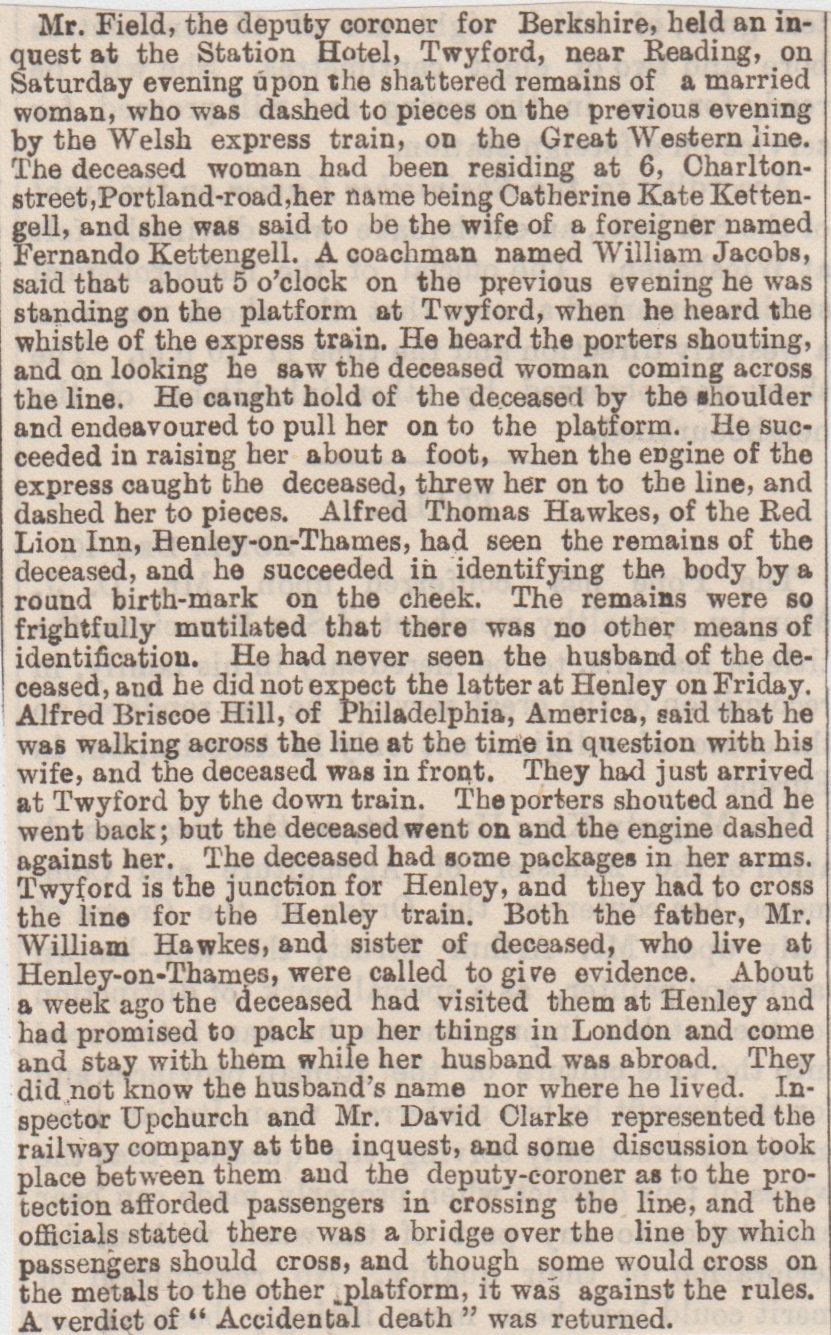
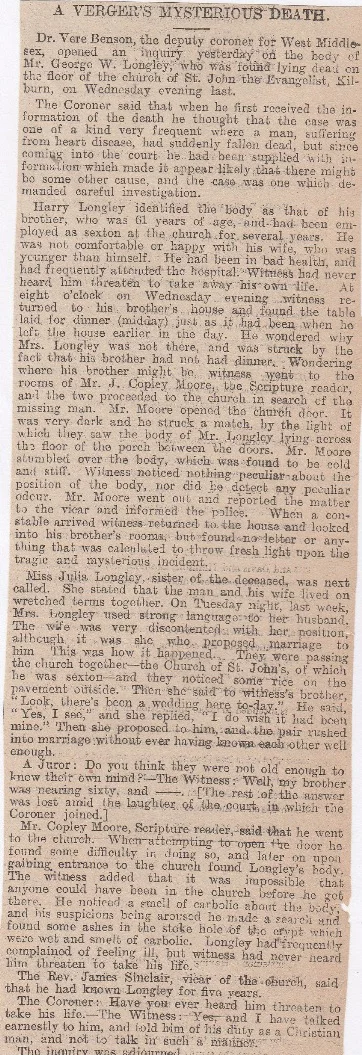


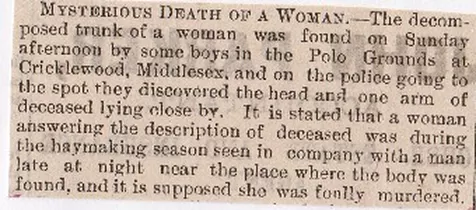

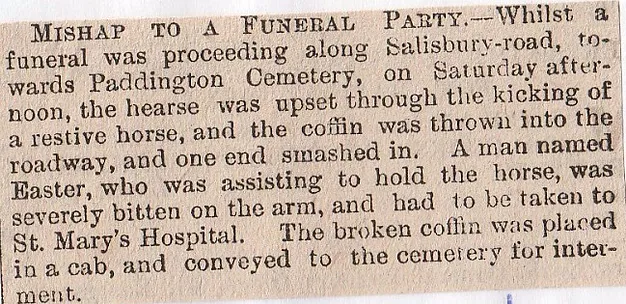
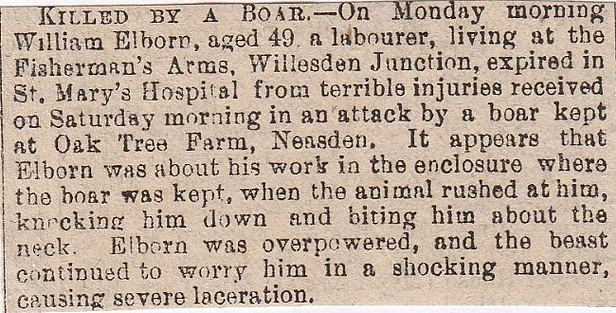
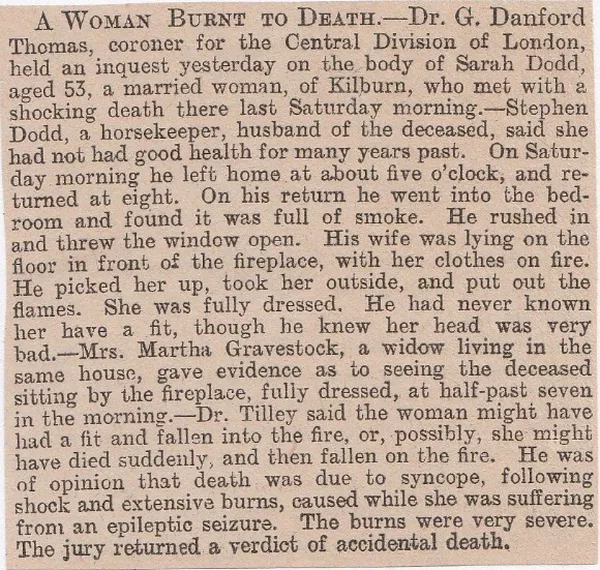
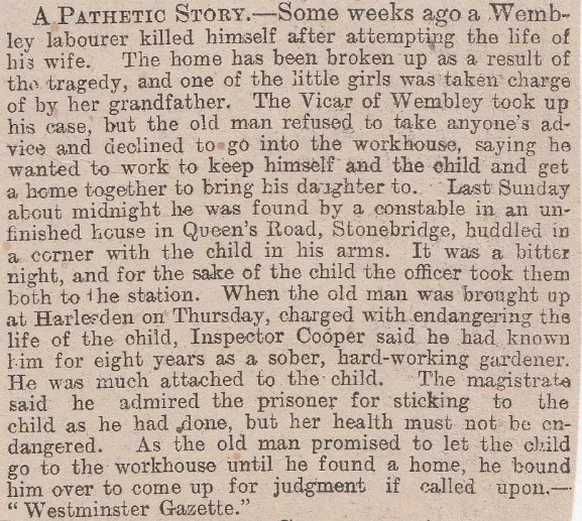

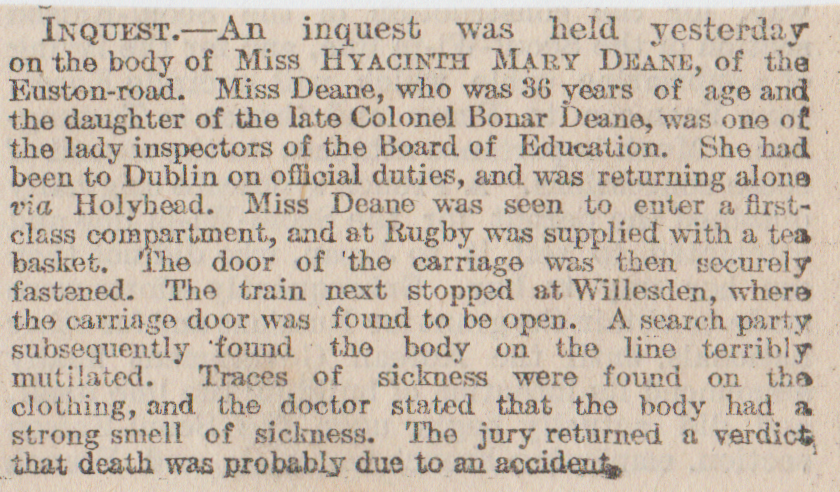
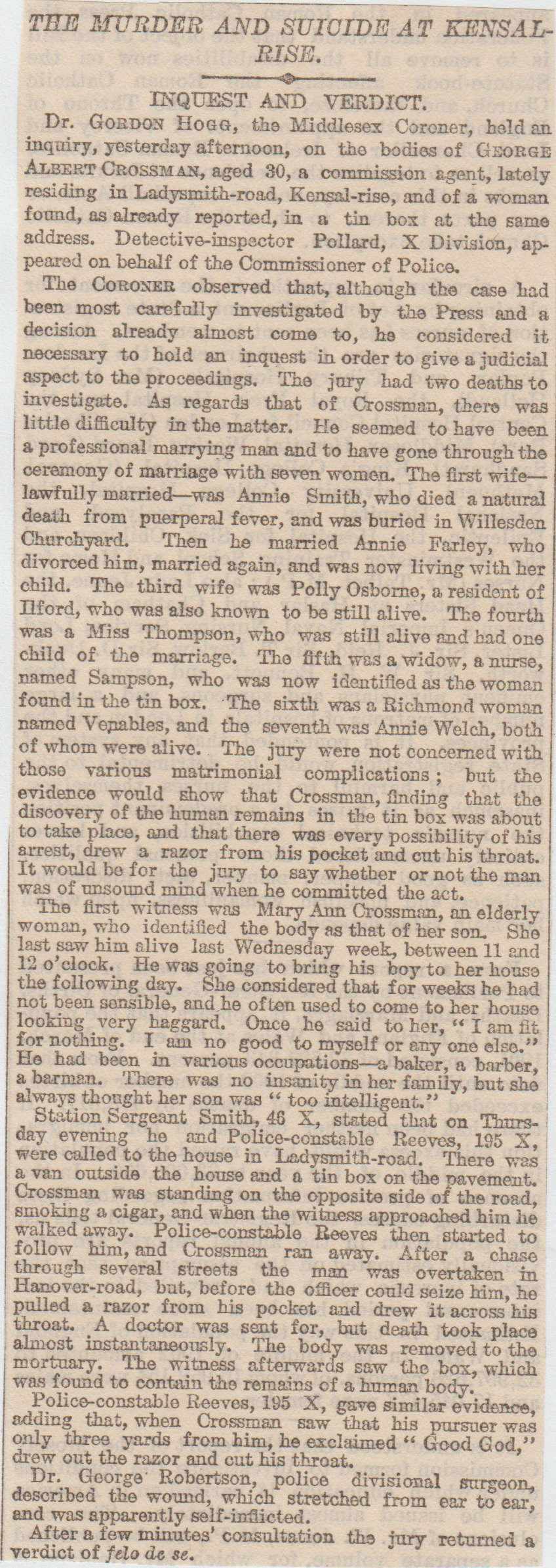

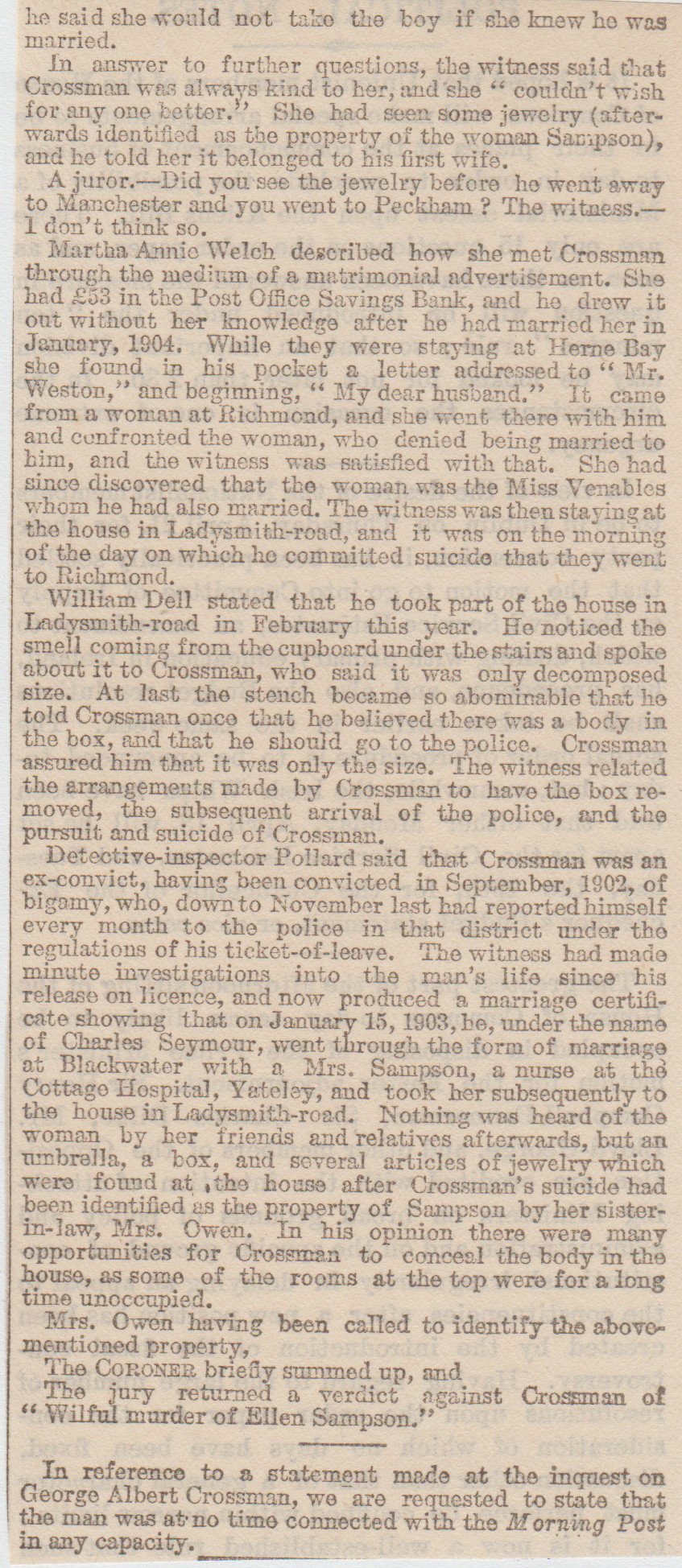
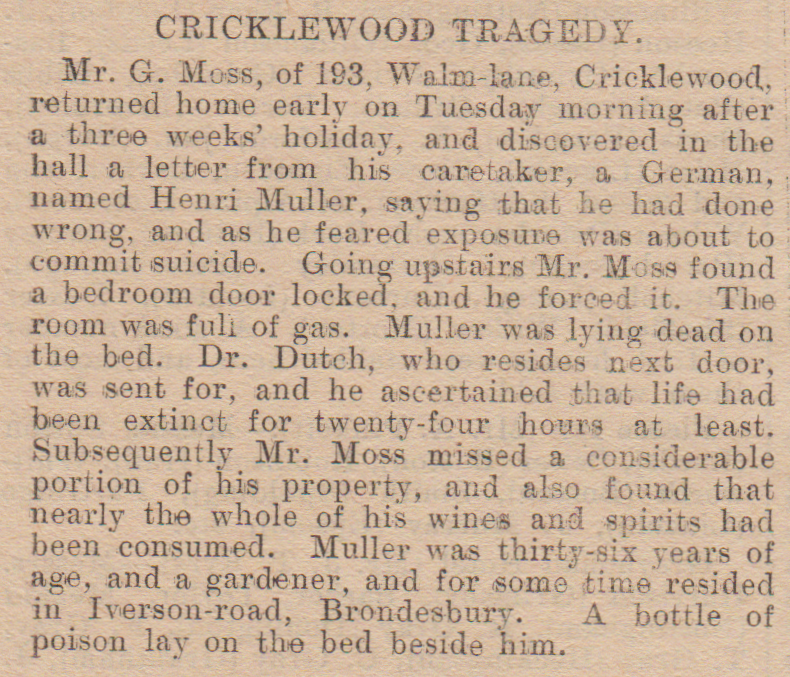

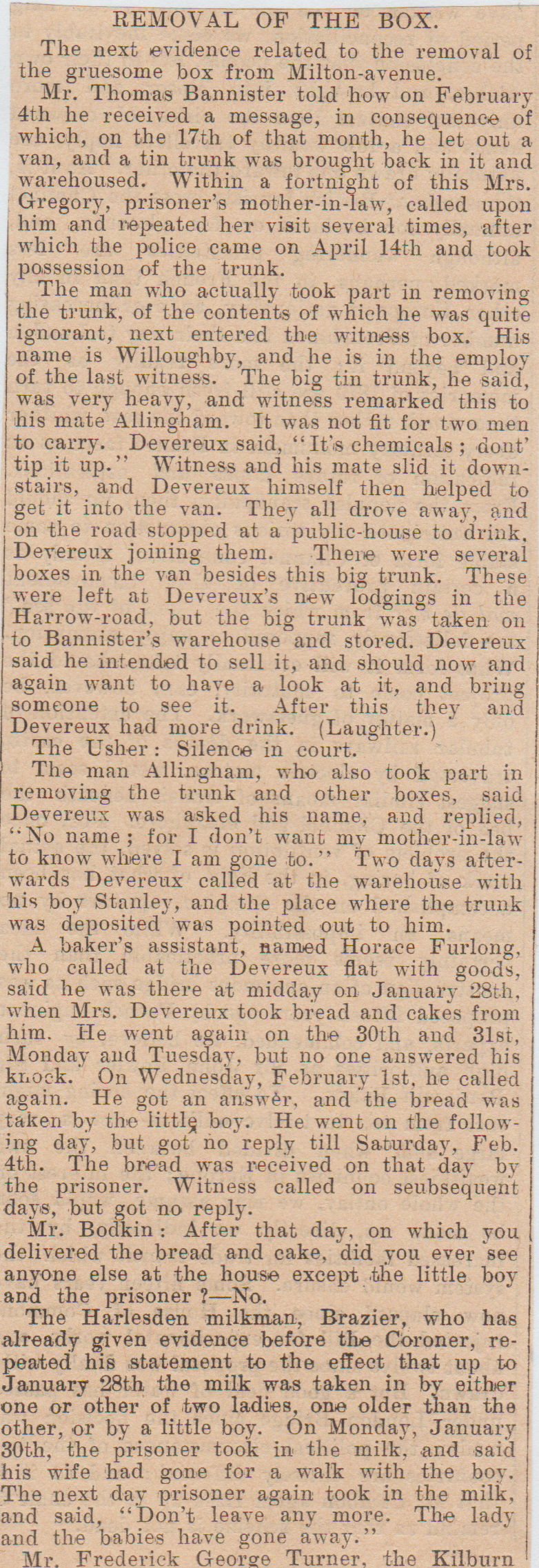
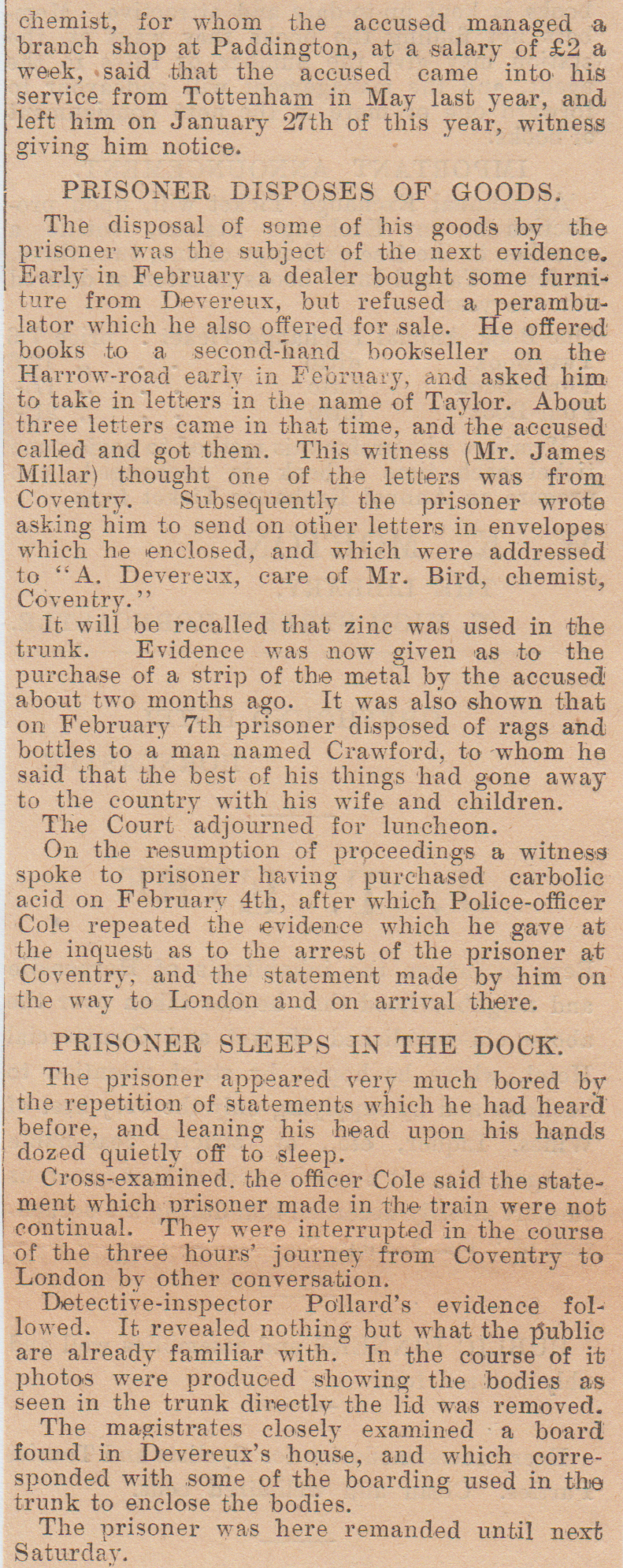

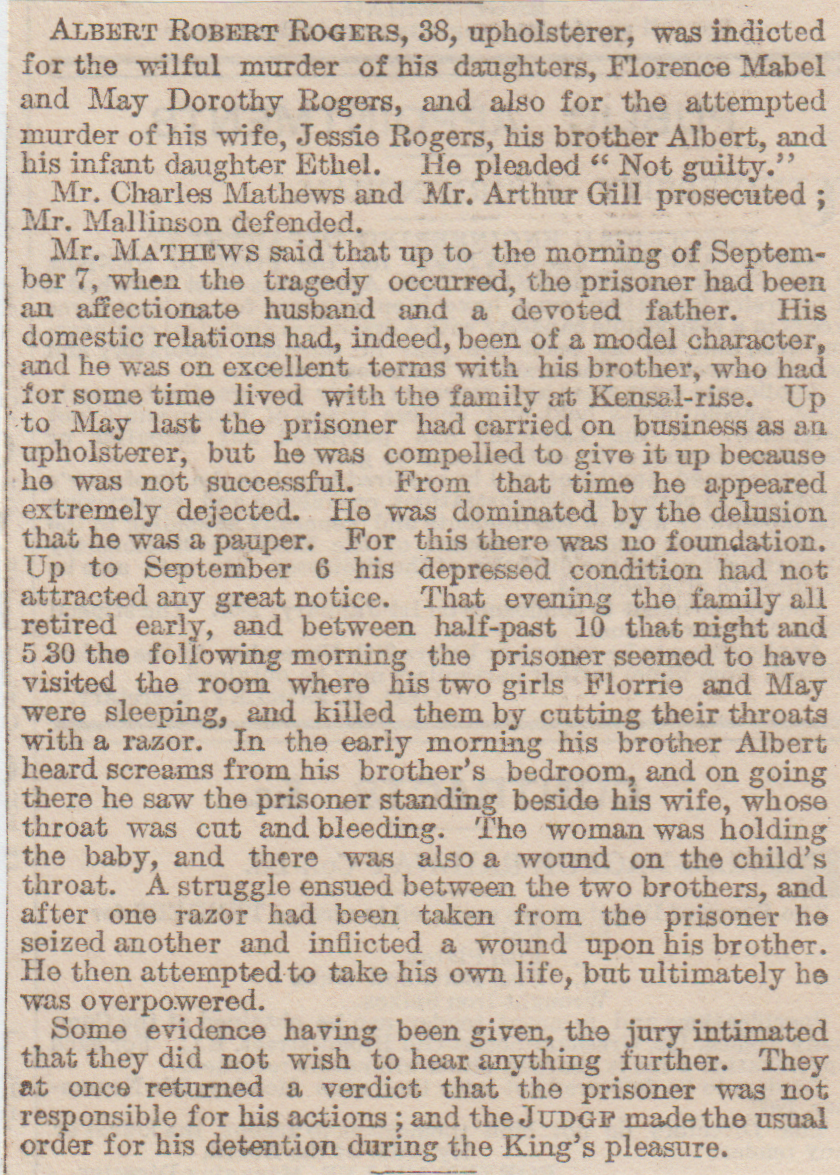



 5/ Windsor Great Park, July 1879
5/ Windsor Great Park, July 1879

 8/ Windsor Castle Suicide, July 1863
8/ Windsor Castle Suicide, July 1863





























